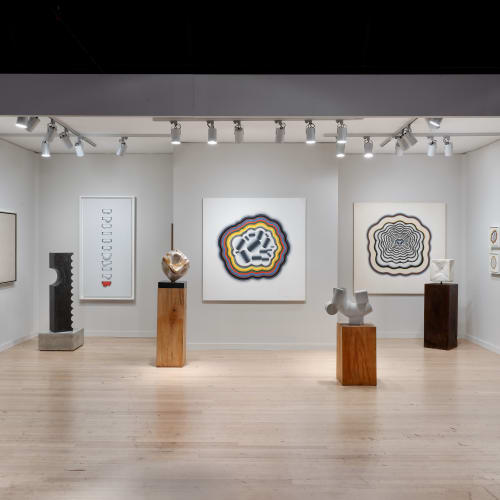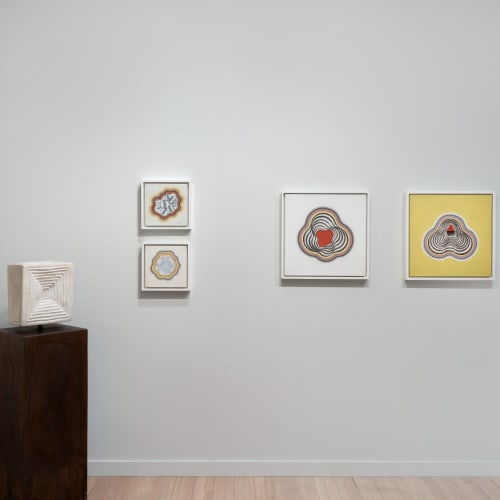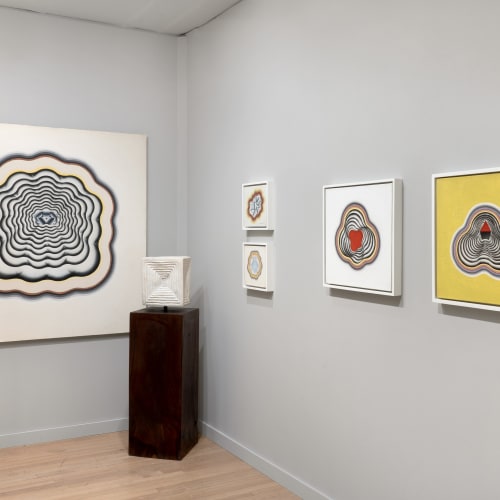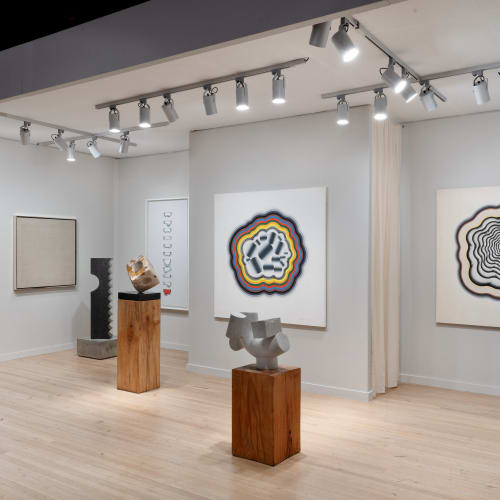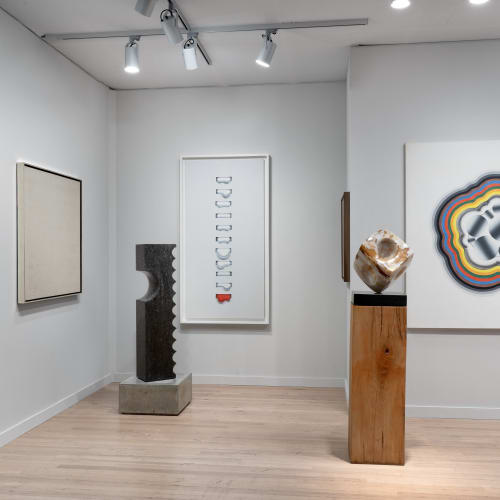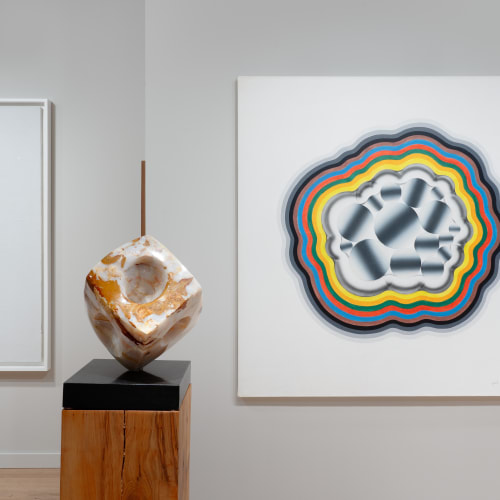For 2023’s ADAA The Art Show, Tina Kim Gallery is pleased to present a historical presentation highlighting the practices of two seminal Asian and Asian-American artists: sculptor Minoru Niizuma (b. 1930, Tokyo; d. 1998, New York) and painter Kim Tschang-Yeul (b. 1929, Pyongannamdo; d. 2021, Paris).
Belonging to a generation that experienced significant political turmoil, Niizuma and Kim migrated to New York in the 1960s from their respective homelands of Japan and Korea. Both artists were deeply engaged with the social and artistic milieu of the city: Niizuma taught at the Brooklyn Academy of Art, whilst Kim had received a Rockefeller scholarship to study at the Art Students League of New York. Although the duration that both artists spent in the city differed greatly—Niizuma would remain in New York for the rest of his life, whilst Kim would depart for Paris after three years—both artists produced significant bodies of work, exhibited actively, and served as important cultural connectors between Asia and New York. Yet, both artists experienced levels of marginalization: Kim Tschang-Yeul left for Paris, citing isolation and alienation from New York society at large. Although Niizuma attained a measure of success during his lifetime, his legacy faded from recognition at the time of his death due to the lack of formal representation.
Bringing together sculptures of Niizuma, as well as paintings by Kim, the presentation will include works that both artists created during their time in New York, revealing how it led to the development of the artists’ signature styles in their chosen mediums. Their approach to painting and sculpture respectively broaden definitions of “Western” art movements. Although affiliated with the emerging artistic cluster that became known as “Minimalism,” for example, Niizuma’s works differed from the systematic, pre-fabricated, timeless approach employed by artists such as Donald Judd, Dan Flavin, and Carl Andre. Instead, Niizuma consistently emphasized the intrinsic properties of his oft-chosen mediums: marble and granite. His earlier work from the 1960s are often characterized by highly polished surfaces and geometric forms. This slowly evolved into works such as Windy Wind (c.1970s), where the surfaces of the sculptures are marked by grooves, crags, and furrows. Yet, the rough-hewn appearance of Niizuma’s works is contrasted with the organic, fluid forms that the artist employed. Harboring a love of mountain climbing, many of the forms of Niizuma’s sculptures are inspired by his own encounters with natural environments, which he alludes to in the title of each respective work.
Similarly, when Kim Tschang-Yeul moved to New York in 1965, Pop Art prevailed as the artistic lifeblood of the city. During this time, Kim became acquainted with the artist Nam June Paik who later supported Kim’s participation in the Avant-Garde Festival in 1969. It was in New York that Kim began his earliest experiments into painting the bulbous abstract forms that would later lead to his signature style—the waterdrop. It was during this time that the artist began experimenting with visceral abstraction, depicting colorful spherical forms which the artist aptly called “paintings of the intestines.” Drawing from the Pop Art and Minimalism he encountered in New York, Kim continued his study of pure abstraction until 1969, at which point he began producing globular, phlegmatic forms that appear to ooze out through the canvas, as in the painting Untitled (1971). The following year, the artist unveiled a painting of a magnified single drop of water in the first exhibition at Salon de Mai in Paris, France. It was Kim’s ability to navigate between diverse modes of abstraction, minimalism, and photorealism that led him to settle into this motif that he would continue to pursue.
By embracing the transient properties of elemental materials such as water and stone, informed by their connection with nature and their spiritual practice of Taoism, respectively, Niizuma and Kim created work that celebrated the human condition of being at once vulnerable and resilient, fleeting and full, impermanent and impactful. Through centering the work of two artists previously marginalized in the 1960s New York art scene, and in its subsequent documentation in the annals of art history, we hope to broaden the contemporary understanding of 20th century modernism beyond the canonical artists and movements already well-remembered from that period. Today, both Niizuma and Kim’s works have been collected by major American museums, including the Hirshorn Museum and Sculpture Garden, the Solomon R. Guggenheim Museum, the Museum of Modern Art, Albright-Knox Art Gallery, amongst other international institutions besides.
ABOUT ARTISTS
Kim Tschang-Yeul (1929-2021) first moved to New York in 1966 after receiving a scholarship from the Rockefeller Foundation to study at the Art Students League. He joined a social circle of Asian-American artistic figures in the city that included Kim Whanki, Nam June Paik, Hwang Byungi, and Kun-woo Paik, who frequently gathered in the home of John Pai, then the head of the undergraduate sculpture department at Pratt. His work from the 1960s mostly consisted of biomorphic, colorful abstract compositions, which would lead to his decades-long devotion to the subject of the water drop. Kim felt that water drops embodied the Eastern philosophical idea of “full emptiness”, or the achievement of enlightenment through simplicity and focus. His paintings sought to capture the beauty and clarity contained in these small, transparent phenomena, apt to quickly disappear but representative of the unexpected power of spare and ephemeral things.
Kim studied art at Seoul National University and The Art Students League of New York. He exhibited in numerous group and solo exhibitions globally throughout his career, including solo exhibitions at the Gwanju Museum of Art (2014), the National Taiwan Museum of Fine Arts (2012), Busan Museum of Art (2009), National Art Museum of China (2005), and the National Museum of Modern and Contemporary Art in Gwacheon, Korea (1993). Notable group exhibitions include Abstraction(s) at the Song Art Museum (2019), Beginning the New Era at the National Museum of Contemporary Art in Seoul (2009), the 2000 Gwanju Biennale, and Made in France at the Centre Pompidou (1997). Kim Tschang-Yeul’s work belongs in many notable collections worldwide, including the Albright-Knox Art Gallery, the Busan Museum of Art, the Los Angeles County Museum of Art, the National Museum of Modern Art in Tokyo, the Museum of Fine Arts in Boston, and the Hirshhorn Museum and Sculpture Garden in Washington, D.C. The Kim Tschang-Yeul Art Museum, an institution dedicated to preserving the artist’s work and legacy, opened on Jeju Island in South Korea in 2016.
Minoru Niizuma (1930-1998) moved to New York in 1959, where he taught at the Brooklyn Museum Art School and Columbia University while exhibiting in multiple museum shows in New York throughout the 1960s and 70s including the Solomon R. Guggenheim Museum, the Museum of Modern Art, and multiple Whitney annuals. He primarily worked with granite and marble, often contrasting rough and smooth surfaces in a manner that both anticipated the effects of time and embraced them. Niizuma, once a fisherman in Hokkaido who was intimately familiar with the power of water and other natural forces, was fundamentally opposed to the symbolic associations of marble with empire and permanence. Like the waterfalls and rivers often referenced in the titles of his pieces, Niizuma carved his sculptures with the assurance that stone, like all else, is susceptible to the erosion of time and the elements.
Niizuma studied art at the National Tokyo University of the Arts before immigrating to the United States. After establishing his studio in New York, he went on to exhibit in many major exhibitions domestically and abroad, including the Solomon R. Guggenheim Museum (1987, 1982, and 1973), the Calouste Gulbenkian Museum in Lisbon (1986), The National Museum of Modern Art in Tokyo (1974), the Whitney Museum of American Art (1968, 1966), the 1967 Pittsburgh International, and the Museum of Modern Art in New York (1966). His work belongs in many distinguished collections globally, including the Hirshhorn Museum and Sculpture Garden in Washington, D.C., the Museum of Modern Art in New York, The San Francisco Museum of Modern Art, The National Museum of Modern and Contemporary Art In Korea, the Solomon R. Guggenheim Museum, and the Williams College Museum of Art.
